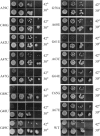Characterization of conserved bases in 4.5S RNA of Escherichia coli by construction of new F' factors
- PMID: 18805981
- PMCID: PMC2583608
- DOI: 10.1128/JB.00995-08
Characterization of conserved bases in 4.5S RNA of Escherichia coli by construction of new F' factors
Abstract
To more clearly understand the function of conserved bases of 4.5S RNA, the product of the essential ffs gene of Escherichia coli, and to address conflicting results reported in other studies, we have developed a new genetic system to characterize ffs mutants. Multiple ffs alleles were generated by altering positions that correspond to the region of the RNA molecule that interacts directly with Ffh in assembly of the signal recognition particle. To facilitate characterization of the ffs mutations with minimal manipulation, recombineering was used to construct new F' factors to easily move each allele into different genetic backgrounds for expression in single copy. In combination with plasmids that expressed ffs in multiple copy numbers, the F' factors provided an accurate assessment of the ability of the different 4.5S RNA mutants to function in vivo. Consistent with structural analysis of the signal recognition particle (SRP), highly conserved bases in 4.5S RNA are important for binding Ffh. Despite the high degree of conservation, however, only a single base (C62) was indispensable for RNA function under all conditions tested. To quantify the interaction between 4.5S RNA and Ffh, an assay was developed to measure the ability of mutant 4.5S RNA molecules to copurify with Ffh. Defects in Ffh binding correlated with loss of SRP-dependent protein localization. Real-time quantitative PCR was also used to measure the levels of wild-type and mutant 4.5S RNA expressed in vivo. These results clarify inconsistencies from prior studies and yielded a convenient method to study the function of multiple alleles.
Figures




Similar articles
-
Conformation of 4.5S RNA in the signal recognition particle and on the 30S ribosomal subunit.RNA. 2005 Sep;11(9):1374-84. doi: 10.1261/rna.7219805. Epub 2005 Jul 25. RNA. 2005. PMID: 16043501 Free PMC article.
-
Crosslinking of 4.5S RNA to the Escherichia coli ribosome in the presence or absence of the protein Ffh.RNA. 2002 May;8(5):612-25. doi: 10.1017/s1355838202020095. RNA. 2002. PMID: 12022228 Free PMC article.
-
Crystal structure of the ffh and EF-G binding sites in the conserved domain IV of Escherichia coli 4.5S RNA.Structure. 2000 May 15;8(5):527-40. doi: 10.1016/s0969-2126(00)00137-4. Structure. 2000. PMID: 10801497
-
Mammalian and Escherichia coli signal recognition particles.Mol Microbiol. 1994 Jan;11(1):9-13. doi: 10.1111/j.1365-2958.1994.tb00284.x. Mol Microbiol. 1994. PMID: 8145649 Review.
-
What do we know about ribosomal RNA methylation in Escherichia coli?Biochimie. 2015 Oct;117:110-8. doi: 10.1016/j.biochi.2014.11.019. Epub 2014 Dec 13. Biochimie. 2015. PMID: 25511423 Review.
Cited by
-
Divergently Transcribed ncRNAs in Escherichia coli: Refinement of the Transcription Starts Assumes Functional Diversification.Front Mol Biosci. 2021 Mar 3;8:610453. doi: 10.3389/fmolb.2021.610453. eCollection 2021. Front Mol Biosci. 2021. PMID: 33748186 Free PMC article.
-
Fingerloop activates cargo delivery and unloading during cotranslational protein targeting.Mol Biol Cell. 2013 Jan;24(2):63-73. doi: 10.1091/mbc.E12-06-0434. Epub 2012 Nov 7. Mol Biol Cell. 2013. PMID: 23135999 Free PMC article.
References
-
- Batey, R. T., R. P. Rambo, L. Lucast, B. Rha, and J. A. Doudna. 2000. Crystal structure of the ribonucleoprotein core of the signal recognition particle. Science 2871232-1239. - PubMed
-
- Batey, R. T., M. B. Sagar, and J. A. Doudna. 2001. Structural and energetic analysis of RNA recognition by a universally conserved protein from the signal recognition particle. J. Mol. Biol. 307229-246. - PubMed
-
- Bernstein, H. D. 2000. A surprising function for SRP RNA? Nat. Struct. Biol. 7179-181. - PubMed
-
- Brown, S. 1991. 4.5S RNA: does form predict function? New Biol. 3430-438. - PubMed
Publication types
MeSH terms
Substances
Grants and funding
LinkOut - more resources
Full Text Sources

